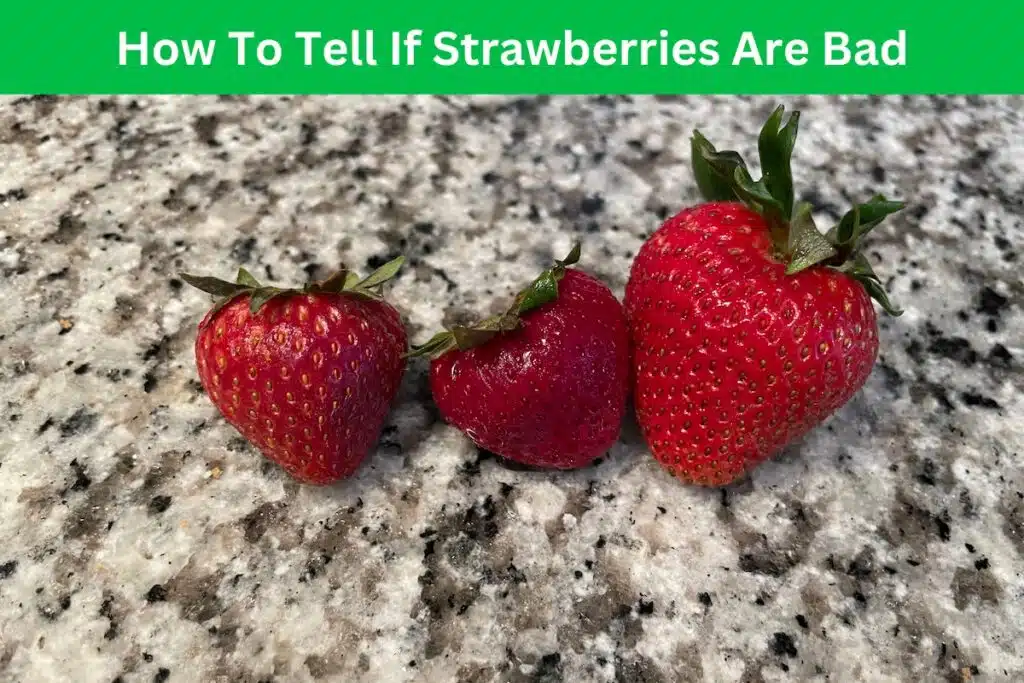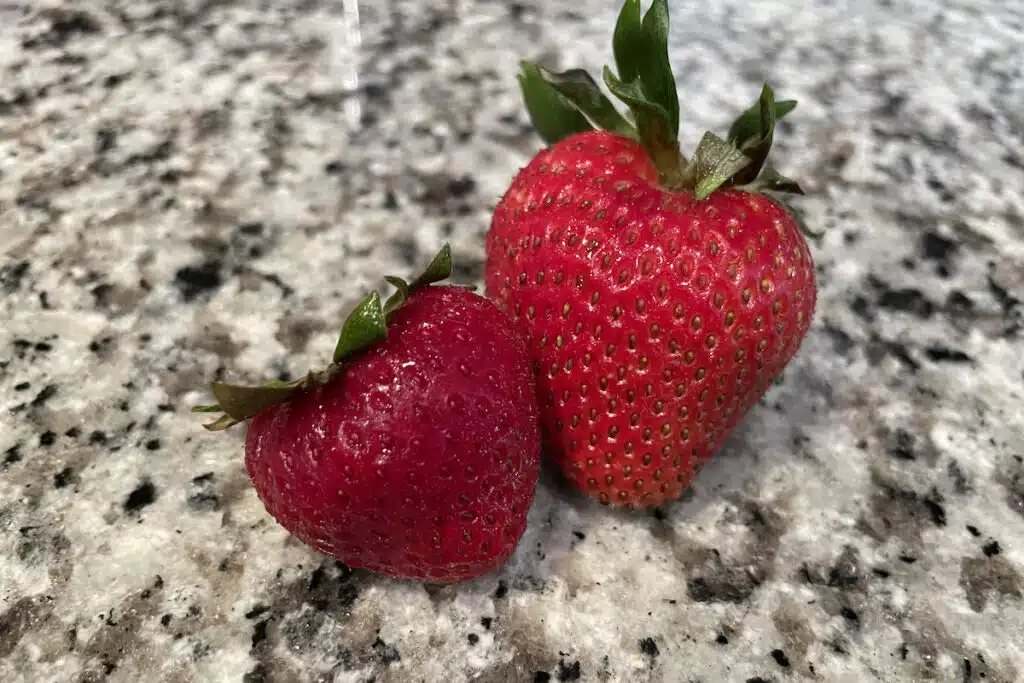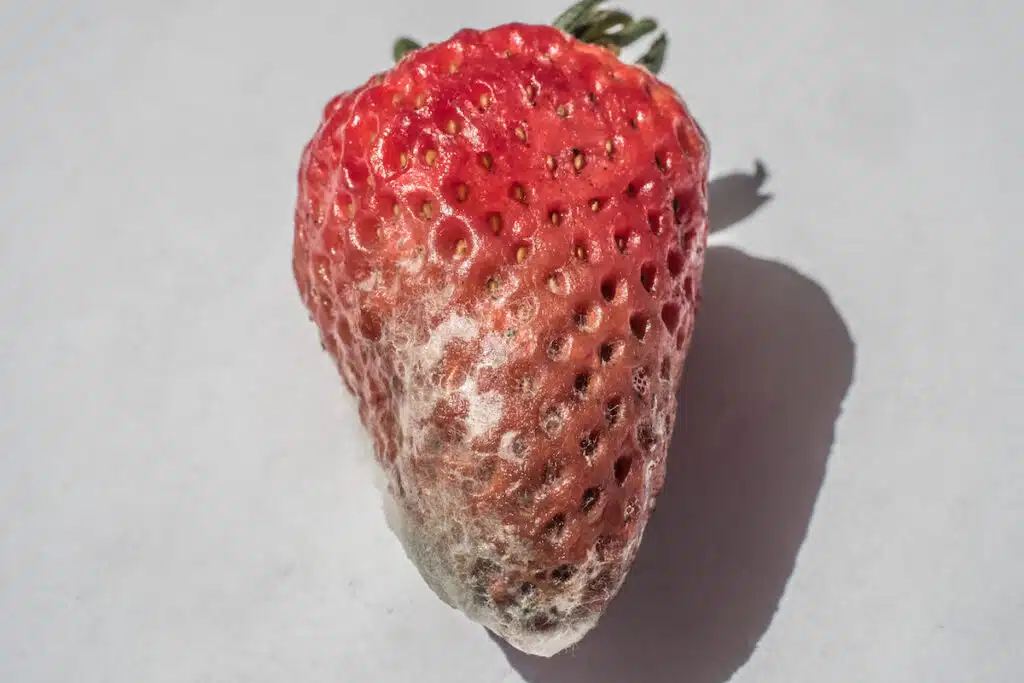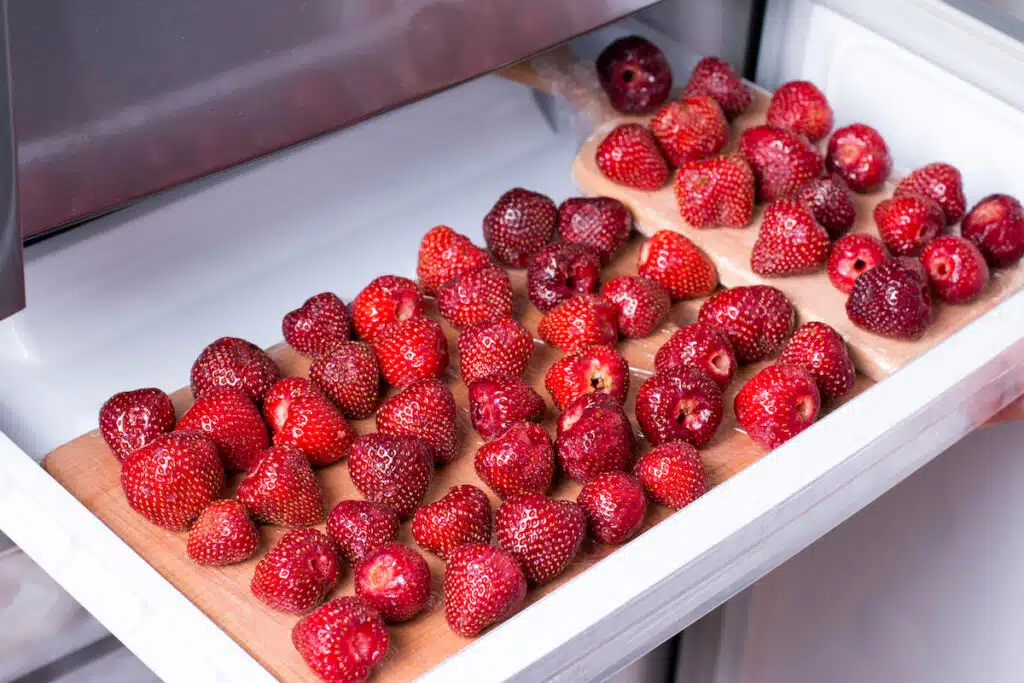Strawberries are undoubtedly one of the most delicious and versatile fruits available. However, their delicate nature makes them susceptible to spoil if not handled and stored properly. How do you tell if your strawberries are bad or going bad?
In order to enjoy the best of these sweet berries, it is important to recognize the signs of bad strawberries and learn how to store them to extend their freshness.
Go here if you are looking for a u-pick strawberry farm in your area!
In this guide, we will explore the key signs of spoiled strawberries, discuss the importance of proper storage, and even share creative uses for overripe strawberries. We will share with you on how you can tell if strawberries are bad so you can enjoy them at their peak ripeness.

Short Summary
- Identify key signs of spoiled strawberries such as mold growth, discoloration, off smell and texture changes.
- Refrigerate and store on single layer to extend shelf life. Wash before use.
- Freeze for up to 3 months or get creative with overripe fruit, but discard if spoiled.
Identifying Bad Strawberries: Key Signs To Watch For

Identifying bad strawberries is crucial to avoid eating spoiled or bad tasting strawberries. This can ensure you are enjoying the delicious flavors and nutrients of this fruit.
Some of the key signs that indicate strawberries have gone bad include mold growth, discoloration, an off smell, and a soft or mushy texture.
By paying close attention to these signs, you can avoid consuming spoiled strawberries and enjoy your fruit at its prime.
Knowing how to detect bad strawberries also helps you store them properly, preventing them from spoiling other fruits in the same container. It is important to remove any spoiled strawberries from the rest of the bunch, ensuring the remaining berries stay fresh.
Mold Growth
Mold growth is a clear indication that your strawberries are no longer good to eat. This is one of the most common signs of bad strawberries.
Mold is a type of fungus that appears on the surface of fruits. It can take various forms such as white, blue or green patches.

It is crucial to discard any moldy strawberries to prevent the spread of mold to the other berries in the container or bag, as mold can rapidly spread its roots and spores, even if it’s not immediately visible.
When inspecting your strawberries for mold, be sure to check both the exterior of the berries and the interior of the packaging, as one contaminated strawberry can cause rapid mold growth when in contact with others.
Discoloration
Discoloration is another sign that your strawberries may be starting to spoil. This can be identified by dark or brown spots and a loss of color in the fruit. Discoloration can be caused by a lack of ripeness, inadequate storage and exposure to oxygen, or prolonged storage resulting in decomposition.
While discolored and shriveled strawberries may be a sign of spoilage, they may still be suitable for consumption within the same or following day, if there are no other indications of spoilage such as mold or spots.
When choosing strawberries, look for deep red berries with a slightly green tint, as this indicates optimal ripeness before freezing.
Off Smell
The smell of strawberries can also be an indicator of their freshness. A ripe and healthy strawberry should have a sweet, unmistakable aroma that sets it apart from other fruits and berries. As strawberries begin to decay, they release ethylene gas, which accelerates the spoilage process and results in a bad smell.
An off smell in strawberries may resemble the scent of alcohol, which is a sign that the fruit is beginning to spoil. Trusting your senses is important when assessing the freshness of strawberries, and if you detect a bitter or sour smell, it is best to discard the fruit.
Texture Changes: Soft and Mushy Strawberries
Texture changes can also indicate spoilage in strawberries. Strawberries should be firm yet ripe to the touch. When pressed lightly, they should have some give. Softening or shriveling of the texture, as well as bruising and leaking, can be indicative of spoilage in strawberries.
Consuming mushy strawberries is not recommended, as they are in the process of decomposition and may contain bacteria or mold. Bacterial activity is known to be a contributing factor to the soft and mushy texture of strawberries.
Plus soft strawberries may not taste the best!
Squishy or Shriveled Texture
A good-quality strawberry should have a firm texture when touched and show no signs of spots or bruises. Overripe strawberries, on the other hand will have a soft and mushy texture.
The texture of spoiled strawberries is typically soft or shriveled, which is a clear sign that they are no longer good to eat.
Bruising and Leaking Juice
Aside from the soft and mushy texture, bruising and juice leakage can also indicate that strawberries are deteriorating in quality. If strawberries are exuding juice, it usually indicates they are deteriorating, but they can still be eaten.
Bruising can be indicative of a strawberry’s poor quality, particularly if there are extensive or multiple bruises present. If the strawberries are severely bruised, mushy, and leaking juice, they should be discarded, as this is usually a sign that the strawberry is going bad.
Taste Test: How Flavor Can Indicate If Strawberries Are Bad
The taste of strawberries can be a helpful indication of their freshness. A sweet taste indicates that the strawberries are fresh and delicious, while a sour or bitter taste can indicate your strawberries are bad.
If you come across strawberries with an off taste, you will probably just throw them away. Fresh strawberries should have an enticing aroma that sets them apart from other fruits and berries. They should also have a pleasant, sweet taste. Use this taste test as an additional tool to ensure you are consuming only the freshest and most delicious strawberries.
Storing Strawberries: Tips for Longer Shelf Life
Proper storage is key to extending the shelf life of strawberries and maintaining their freshness.
In this section, we will explore some essential tips for storing strawberries, such as refrigeration, single layer storage, and washing before use. The goal of storing strawberries is that they will be good for a longer period of time, allowing you to enjoy them longer before they go bad.
Implementing these storage tips not only keeps your strawberries fresh, but also helps prevent the rapid deterioration that can lead to them spoiling faster. The longer your strawberries stay fresh, the more time you have to enjoy their delightful taste and make the most out of these amazing berries!
Our kids love picking strawberries so when we go to a u-pick strawberry farm, we usually come home with way more than we know what to do with! Instead of letting them go to waste we make sure we follow these storage tips so they will last longer.
Refrigeration
Refrigeration is a great way of keeping strawberries fresh. Storing strawberries in an airtight container in the refrigerator is the most effective way to maintain their freshness. The use of an airtight container helps preserve the strawberries’ freshness and prevent the growth of bacteria or mold.
We found that putting our strawberries into a container also stops them from absorbing different odors from within our refrigerator.
When storing strawberries in your refrigerator, it is important to ensure that they are completely dry before placing them in the container. If they are not dry, the strawberries begin to spoil faster.
When stored properly, strawberries can remain fresh for up to 7 days in the refrigerator, giving you time to enjoy their delicious flavor.
Single Layer Storage
Storing strawberries in a single layer is an effective technique to prevent them from being crushed. To store strawberries in a single layer, place unwashed strawberries with a paper towel to absorb moisture in a container.
This method of storage allows for better air circulation around strawberries, preventing the growth of mold and bacteria. Additionally, the paper towel helps to absorb any excess moisture that might contribute to the deterioration of the fruit, keeping your strawberries fresh and ready to enjoy.
Washing Before Use
It is important to wash your strawberries before eating or using them in recipes, but the timing of washing is crucial. Washing strawberries immediately before use is recommended, as it prevents the growth of bacteria and mold on the moist fruit surface.
How we clean our strawberries is just by putting them into a colanders and running cool water through them for a few minutes. Usually they aren’t that dirty and don’t have fruit flies or other insects.
Freezing Strawberries: A Guide to Preserving Freshness

Freezing strawberries is an excellent way to preserve their freshness for up to three months, making it a great method for those who want to enjoy strawberries even when they are out of season.
To freeze strawberries, it is important to follow the proper steps, such as removing stems, freezing uncovered on a baking sheet, and storing them in a Ziploc bag or airtight container.
By freezing strawberries, you can have a supply of delicious fruit on hand whenever the craving strikes, and you don’t have to worry about them going bad.
Follow these recommended preparation steps and freezing techniques to make sure your strawberries stay fresh.
Preparation Steps
Before freezing strawberries, it is important to prepare them properly to ensure they retain their freshness and quality. Begin by rinsing the strawberries under cool water, patting them dry with a paper towel, and hulling them by removing the green cap and pale flesh with a paring knife or a strawberry huller.
If you are in a hurry you can simply cut the top off, right where the white section of the strawberry meets the red.
Once the strawberries are clean and hulled, they are ready to be frozen. Make sure your strawberries are completely dry before placing them in the freezer, as excess moisture can cause the fruit to stick together.
Freezing Techniques
After preparing the strawberries, it’s time to freeze them. Start by placing the strawberries in a single layer on a baking sheet, making sure they are not touching each other. Freeze the strawberries uncovered until they are frozen solid, then transfer them to a Ziploc bag or airtight container for long-term storage.
By using these freezing techniques, you can preserve the freshness and quality of your strawberries, allowing you to enjoy their delicious flavor even when they are not in season.
Whether you want to use frozen strawberries in smoothies, baked goods, or simply enjoy them as a cool snack, proper freezing techniques ensure you will have a supply of fresh-tasting fruit on hand.
Overripe Strawberries: Creative Uses
If you find yourself with overripe strawberries that are no longer suitable for snacking, don’t throw them out!
Overripe strawberries can still be used creatively in various recipes, allowing you to get the most out of your fruit. Consider using overripe strawberries in smoothies, yogurt snacks, ice cream, or even cake.
Not only do these recipes make the most of the remaining flavor in overripe strawberries, but they also help to reduce wasted berries.
So next time you find yourself with a batch of overripe strawberries, don’t hesitate to get creative and whip up something delicious.
Make Sure You Watch Out For The Bad Strawberries!
Knowing the signs of bad strawberries and understanding proper storage techniques will allow you to enjoy your recently pick strawberries for a longer time. If you find a bad strawberry, make sure you remove it from the pack.
Our kids sometimes pick bad strawberries and we have to go through every one of them before we store them in our refrigerator. If you miss a bad strawberry, then your entire batch is at risk of spoiling much faster than normal.
We hope you enjoy picking strawberries and don’t forget to support your local farmers!
Frequently Asked Questions
How long will strawberries last in the fridge?
Strawberries can last up to a week in the refrigerator when stored correctly. To maximize their shelf life, make sure they are placed in an airtight container and keep them away from other fruits.
Is it okay to eat strawberries with soft spots?
It is generally safe to eat strawberries with soft spots, as long as they do not show signs of mold or rot.
If the strawberry is severely degraded, it may have lost some of its flavor, so it is best to discard it if that is the case. Most of the time, soft spots on a strawberry just means it has been bruised or pulled on.
Our kids will pull too hard on a strawberry and a few days later that berry will have a soft spot.
How long does it take for strawberries to go bad?
Strawberries are very perishable and need to be stored correctly to keep them fresh. When stored in the refrigerator, strawberries will usually stay fresh for up to 7 days.
However, when stored at room temperature, they can start to go bad within a few days. If you leave your strawberries out, fruit flies will eventually take over or other insects like ants will find your strawberries.
Are overripe strawberries bad?
Overripe strawberries are not bad to eat, but they may taste bad. Signs of an overripe strawberry will be mushy or very soft – this happens right before it starts to mold. If your strawberry show signs of mold or rot, throw it away.
Otherwise, if the strawberry is soft and degraded, it may still be edible, but likely won’t taste very good.
How do I know if a strawberry has gone bad?
To determine if a strawberry has gone bad, inspect the strawberry closely and look for signs of mold or discoloration. If there is a sour smell or texture to the fruit, it’s likely past its prime and should be thrown away. It doesn’t take long to look over strawberries and see that they are still good or have gone bad.
